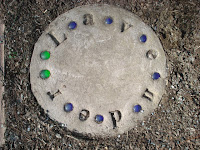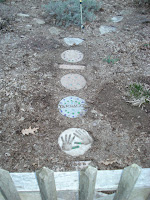 |
| Stepping stone |
Imagine walking out the door and stepping into a fragrant garden to gather fresh herbs for a dish you're creating. If you have a small sunny area near your door (preferably a kitchen door), an herb garden could easily become a reality. Herbs are simple to grow, requiring only fertile soil and six hours of sun. Herbs are fragrant (my favorite garden to tend), abundant (harvesting encourages more growth), and they are the essence of fine cooking.
Deer are rarely attracted to herbs (a three foot fence protects mine easily). Because most have lovely greenery and attractive flowers, you can simply add a few of your favorites to a sunny flower garden. Planting a small plot with the herbs that you use the most in cooking, will supply you with fresh or dried organic herbs throughout the year for a minimal annual cost.
Deer are rarely attracted to herbs (a three foot fence protects mine easily). Because most have lovely greenery and attractive flowers, you can simply add a few of your favorites to a sunny flower garden. Planting a small plot with the herbs that you use the most in cooking, will supply you with fresh or dried organic herbs throughout the year for a minimal annual cost.
 Some dependable culinary herbs for a beginning herb garden in New York are:
Some dependable culinary herbs for a beginning herb garden in New York are:perennials (chives, sage, oregano, tarragon, thyme, and lavender)and annuals (basil, parsley, coriander, rosemary, dill, marjoram, and bay leaf).
Plant the perennials as soon as the garden area is ready in spring; plant annuals after the last frost. Create paths in the garden to allow for easy access to each plant for continued harvest. We use either my daughter’s stone creations or flat stones from our woods. Use whatever is readily available (gravel, stones, slate pieces…) but make sure they are comfortable to step upon. If the stones are too small or rounded, you’ll feel as if you are walking on a tight rope each time you harvest.
If you would like more specific information about growing an herb garden, Skills Off the Grid is offering an herb garden workshop this Saturday at Hanover Hill Farm in Yorktown.




























